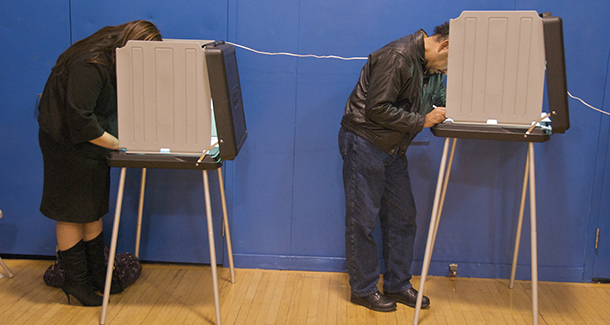
(Photo Credit: Steve Rhodes/Flickr)
A recent post-election panel held by The Future of California Elections (FoCE) to assess the state’s recent primary election revealed a number of issues.
FoCE is a collaborative statewide group funded by the James Irvine Foundation and dedicated to modernizing elections and increasing voter participation.
As one might expect, the voter experience varied widely across the state but a number of problems related to potential disenfranchisement were called out including some confusion among poll workers and voters.
Voters who registered as No Party Preference should have had the option to vote using a cross-over ballot in the Democratic primary. But, not all poll workers offered the alternative ballot and many voters didn’t know to ask for it. In other cases, voters also had mistakenly registered for the American Independent Party – thinking they were independent of any party – rather than registering with no party affiliation. Those voters couldn’t vote for any of the major party candidates.
Deanna Kitamura, project director with Asian Americans Advancing Justice – Los Angeles, highlighted different challenges such as those posed by language barriers. While ballots are available in many languages, not all polling places visibly displayed the options. Without seeing a ballot in their language, some voters apparently simply walked away without casting a vote.
Those registered voters who may have had special needs due to disability or hospitalization may also have been overlooked, according to Fred Nisen, supervising attorney at the Bay Area Regional Office of Disability Rights California. In most places, California requires those who are disabled to pro-actively request assistance in voting and those in hospitals or otherwise unable to travel due to health issues may not have been able to vote.
The state also saw some potential voter intimidation when reports were made about the Siskiyou County Sheriff’s Office making house calls to certain homes in a mostly Hmong area, warning residents of the penalties for voting illegally.
The review panel also included Paul Mitchell, vice president of Political Data, Inc., who provided a numbers review on the primary with a look to the future for California voters. The recent election cycle has seen a record number of new and reregistered voters – a good thing for the political process but one which places more pressure on a voting system already stretched thin due to insufficient funds.
California’s elections are paid for and managed at the county level, where officials are required by the state to implement voting mandates – such as vote by mail and distribution of sample ballots – since they are passed by the Legislature. But since the state’s 2010 budget crisis, the counties haven’t been reimbursed for these mandates
“We’re between a rock and a hard place,” explained panelist Kim Alexander, president of California Voter Foundation. She emphasized the need to treat voters the same throughout the state, regardless of age, ethnicity, language, income or other differences. Without reimbursements from the state, each county is doing the best they can to implement the legislated mandates but there is little or no uniformity. Some counties cut reminder notices to those who vote by mail while others reduce poll worker training to make ends meet.
“Funding directly impacts the voting experience,” said Astrid Garcia Ochoa, deputy director of the Future of California Elections. “Our elections administrators truly care” about the rights of voters and fair and accessible elections, she said. Appropriate funding allows elections to run smoothly and the election officials are responsible for providing a good voting experience. Much like a family on a too-tight budget, elections administrators have to choose what to fund (i.e. vote by mail or updating and maintaining voting systems).
Solving state-local tension over funding elections is key to reducing costs, improving the voter experience and modernizing aging voting technology. There is general agreement that these issues in combination with failing and outdated voting systems require a new funding approach for California's elections.
“Now is the time to focus our efforts on a funding mechanism – election funding remains a top priority for counties throughout the state,” said Neal Kelley, registrar of voters for Orange County.
A model to resolve the current situation can be found in recommendations from California Forward's recent election financing report, “Investing in California’s Democracy: Building a Partnership for Performance.”
The research, headed by Caitlin Maple, California Forward Research Analyst, calls for “a new way to pay for elections administration that can control costs, improve voting systems and evolve the tension-filled relationship between state and county governments into a cooperative partnership.”
Specifically, the report recommends replacing the outdated “mandate reimbursement” process with state funding for the costs associated with the statewide election of officials and statewide ballot measures.
“Developing the right funding model is critical to providing a voting experience that improves public confidence and trust in this most basic act of democracy, and perhaps even voter turnout,” said Maple.
Most other states contribute to the election process in shared funding model with counties taking on most costs for local elections. The proposed solutions also include provisions for the state to incentivize counties to create efficiencies in their voting systems, including utilizing new technologies that may reduce costs and provide for a better voting experience.
“You want voters to keep coming back year after year,” said Garcia Ochoa. And the new proposal from California Forward can help build a better road to the future for all voters.

